Spectrum sharing prevents cellular communications from interfering with existing military communications.
When the FCC first proposed a new radio service in the 3.5 GHz band, they referred to it as the innovation band. The big idea is to use advanced spectrum management techniques to open new licensed and unlicensed spectrum, while protecting incumbent users. Often, we think about innovation based on the air-interface technology employed but here the FCC enabled innovation by establishing a flexible regulatory approach.
Somehow, this new radio service was later dubbed the Citizens Broadband Radio Service (CBRS), a name easily confused with the existing 27 MHz Citizens Band Radio Service (Part 95). Including “Citizens” in the name is misleading, because CBRS normally requires significant infrastructure installed by commercial users, such as enterprises, educational institutions, and mobile network operators (MNOs). The OnGo Alliance is the industry group that was formed to promote CBRS, branding it as OnGo.
CBRS uses the frequency range of 3550 to 3700 MHz, which is in the desirable mid-band range (1 to 6 GHz) for mobile wireless communications. FCC Part 96 contains the rules and regulations governing CBRS.
Tiered license structure
CBRS has three tiers of spectrum use (Figure 1):
Tier 1, Incumbent Users: High-power shipboard and land-based radars, Fixed Satellite Service (FSS) earth stations and grandfathered wireless broadband licensees. These are existing users that have the highest priority.
Tier 2, Priority Access License (PAL): These PAL licensees must avoid interfering with the Tier 1 users but have priority over the Tier 3 users. PAL licenses are sold via FCC auction.
Tier 3, General Authorized Access (GAA): GAA users do not need a license and have access to the band at a lower priority than Tier 1 and Tier 2 users.
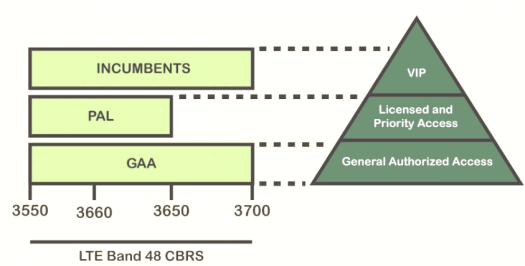
Figure 1. CBRS uses a tiered-priority licensing structure. Source: https://www.private-lte.net/private-lte/cbrs-private-4g-lte-in-band-48/
Rather than force the existing (incumbent) users to move to a different band, CBRS rules protect them from interference from the new users (Priority Access and General Authorized Access). Strictly speaking, these incumbent users are not licensed under Part 96, but the Part 96 regulations are designed to protect them from interference from the new users.
The CBRS spectrum is divided into 15 channels, each 10 MHz wide, for a total of 150 MHz of spectrum. The incumbents may be anywhere in this frequency range, but the PAL licensees are restricted to 3550 MHz to 3650 MHz. The PAL channels are dynamically assigned by the Spectrum Access System (SAS) to avoid interfering with Tier 1 users (more on SAS later in this article). The Tier 3 users also have their channels assigned by the SAS but may use the entire 150 MHz, but at a lower priority than Tiers 1 and 2.
GAA users do not require a license, they operate unlicensed (“Licensed by Rule”). Being on the lowest priority tier, they have no protection from interference. Presumably, the SAS would try to assign channels for GAA users to minimize interference but if many users are active in the same geography, the spectrum will get congested.
The FCC requires the use of digital modulation under CBRS but does not get any more specific than that. This means that CBRS is a frequency band that can be used with a variety of over-the-air signals. Clearly, 4G/LTE and 5G will be used on this band (Table 1) but other air interface technologies could also be deployed. CBRS corresponds to LTE band 48 using time division duplex (TDD), which the latest smartphones already support.
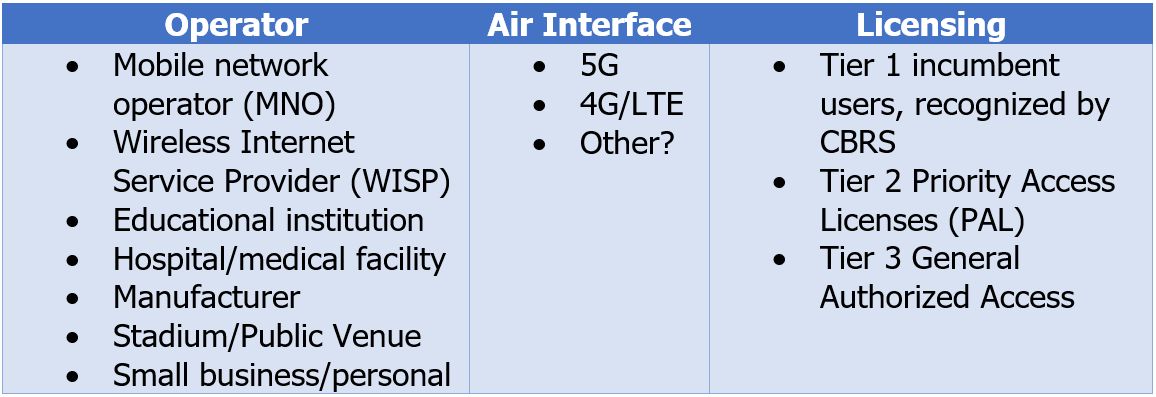
Table 1. The Innovation Band allows for a mix of public and private networks, air interfaces and license types.
Flexible operating models
As designed by the FCC, CBRS spectrum can be used in a variety of deployment models including the much-hyped “private network.” The CBRS sales pitch to enterprises is “own your own network that works with mobile phones, computers, and other devices better than Wi-Fi.” Enterprises often have their own Wi-Fi infrastructure to connect their employees and visitors. An indoor CBRS network can use a similar deployment model.
Sometimes LTE on CBRS is called Private LTE, but this is just one LTE use case. For example, a hospital might want to move critical communications off Wi-Fi to avoid congestion and improve security. It is conceivable that CBRS can replace an existing Wi-Fi network but it is likely that CBRS would be deployed complementary to existing wireless networks. CBRS can be used to wirelessly connect manufacturing operations, with an emphasis on IoT devices.
Wireless Internet Service Providers (WISPs) can use CBRS to provide internet service to their customers, using a Fixed Wireless Access model. The MNOs see CBRS as additional spectrum that can be used to deploy LTE or 5G coverage. This can be via the purchase of PAL licenses or by operating under the GAA tier.
A Neutral Host Network (NHN) is a wireless network that allows multiple MNOs to share the network services. For example, the NHN could be deployed in a stadium that lacks reliable wireless service, using the CBRS band. The NHN could be owned by the stadium or by a third party and would need to have operating agreements with the major NMOs. This type of network provides the end user with solid wireless coverage while seamlessly connecting to their normal provider.
Most of the industry activity is focused on large commercial applications but some vendors are looking to support small businesses and even consumers.
Infrastructure
A wireless access point for CBRS is called a Citizens Broadband Radio Service Device (CBSD). (This is equivalent to eNodeB in LTE and gNodeB in 5G.) There are two categories of CBSD:
Category A CBSDs do not have to be professionally installed, can be indoors or outdoors (with a 6m height above average terrain limit) and are limited to 30 dBm EIRP power level across the 10 MHz channel.
Category B CBSDs can be higher power (47 dBm EIRP in a 10 MHz channel) for outdoor use only. These must be professionally installed.
Note: EIRP is Effective Isotropic Radiated Power, which is the effective radiated power relative to an isotropic antenna.
Figure 2 shows a wireless industrial router that’s CBRS capable.
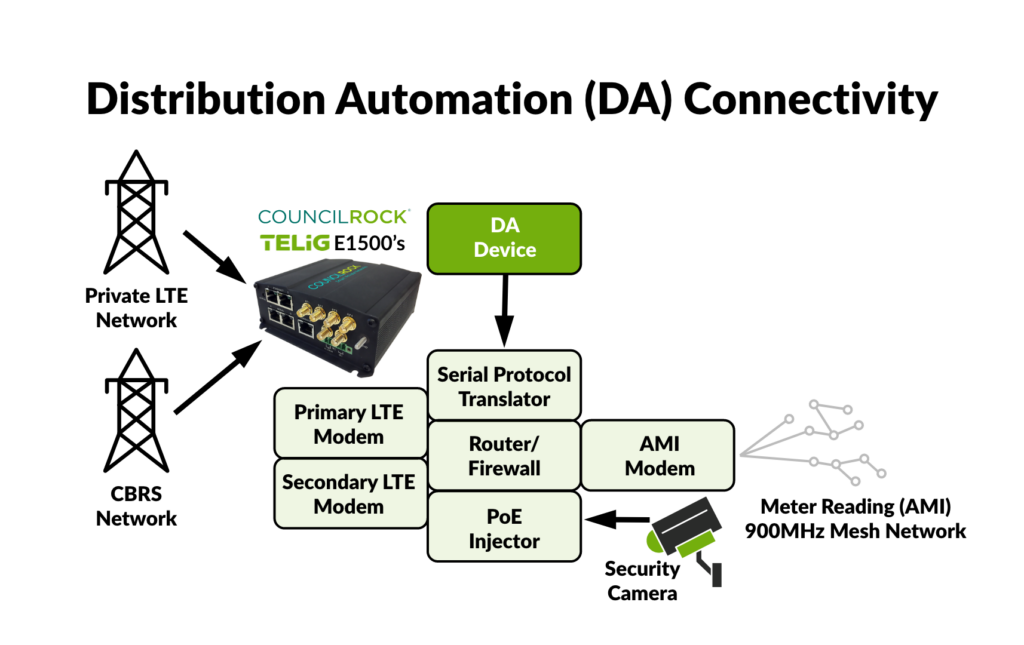
Figure 2. The TELiG E1500 industrial router from Council Rock can operates in the CBRS frequency band, among others. The router connects to DA devices used by electric utilities for data gathering. Source: Council Rock.
Table 2 shows the maximum CBSD power levels, which are both significantly higher than the 200 mW power level of a typical Wi-Fi access point on 2.4 GHz. That translates to better wireless coverage, especially with Category B CBSDs.
There are some important requirements that enable the CBSD to coordinate with an SAS and be an effective part of the dynamically-allocated spectrum management system:
- The CBSD must know its location to within ±50 m.
- The CBSD must register with the SAS and supply its geographic location, antenna height above ground level (in meters), CBSD class (Category A/Category B), requested authorization status (Priority Access or General Authorized Access), FCC identification number, call sign, user contact information, air interface technology, and unique manufacturer’s serial number.
- The CBSD must update the SAS of any changes within 60 seconds.
End-user devices
End-user devices (EUDs) may typically be an LTE or 5G phone, a laptop computer with 4G or 5G capability, or some other wireless-enabled device. The CBRS (Band 48) spectrum is already available on many smartphones and many laptop PCs offer optional 4G or 5G connectivity.
An EUD must operate under the control of a CBSD, always subject to SAS management. Independent EUD-to-EUD transmissions are not allowed. An End User Device is controlled via the CBSD and must discontinue operations, change frequencies, or change its operational power level within 10 seconds of receiving instructions from its associated CBSD. The CBSD receives its instructions from the SAS, so all CBRS transmitters are under the control of the SAS.
Spectrum Access System
The SAS is a cloud-based system that executes the complex spectrum management function that enables the tiered CBRS methodology to work. This is analogous to the traditional approach of frequency coordination but does it on a real-time, dynamic basis, which allows advanced spectrum sharing.
Simply put, the SAS keeps track of incumbent users, PAL users and GAA users. It provides direction to the PAL and GAA CBSDs on frequency and power level to avoid interference, consistent with the tiered priorities. This is a big task and one that will likely require some fine tuning as the CBRS usage increases. But it is all networked together, so the system can be responsive to interference problems. There are multiple SAS Administrators, providing services and competing for business, and they are required to share their data.
An Environmental Sensing Capability (ESC) is a network of RF sensors that detects and communicates the presence of a signal from an incumbent user to an SAS. This may seem like a simple thing to do — just use a collection of RF receivers to listen for military radar — but it is important that the ESC identify incumbent users accurately so that it can predict and avoid potential interference from CBSDs. Accurately modeling the transmitted signals minimizes the impact on both the incumbent user and the CBSD. The FCC has approved multiple ESC providers.
The Wireless Innovation Forum is the industry group working on standards to support CBRS, including protocols for how CBSD’s talk to the SAS and how SAS’s share information.
A PAL user does not get a permanently assigned channel — they must be able to dynamically change frequency based on SAS directions. For example, a PAL may have to change frequency to avoid conflicts when a Tier 1 user begins transmitting.
The SAS is dependent on the internet being continuously available. It operates on a 60 sec heartbeat, with each CBSD checking in with the SAS at that rate. If a CBSD does not receive authorization to continue using a particular channel, it must stop transmitting within 300 sec. This is perhaps the biggest weakness of the system: it is dependent on a reliable connection to the SAS. Recently, the National Football League (NFL) was concerned about their use of CBRS for coach-to-coach communications during football games being interrupted by a loss of internet connectivity to the SAS. The NFL requested and received a waiver from the FCC in case the internet connection fails during a football game [Ref 5]. It seems that other CBRS users would have this same concern when using CBRS for on-site mission critical communications.
PAL auction results
The FCC concluded the first auction of PAL licenses in August 2020, with many of the big communication companies participating: Verizon, Dish Network, Charter Communications, Comcast, Cox Communications, Windstream, and Mediacom [Ref 6]. AT&T was noticeably absent. The winning bidders were quite diverse, including these organizations: Southern California Edison, Sempra Energy, Chevron, John Deere, Texas A&M University, University of Virginia Foundation, Virginia Tech Foundation, and numerous small/rural utilities and telcos. Clearly, there are a wide variety of organizations pursuing CBRS.
Summary
The FCC vision of an innovation band is up and running, with many deployments in the CBRS band. The number of users is growing rapidly, along with a diverse set of applications and use models. This new approach to spectrum sharing is going to be interesting to watch, as problems are encountered and addressed. This will probably be an important regulatory model for future FCC spectrum management decisions.
References
-
- “Amendment of the Commission’s Rules with Regard to Commercial Operations in the 3550-3650 MHz Band,” Report and Order and Second Further Notice of Proposed Rulemaking, GN Docket No. 12-354, Federal Communications Commission, April 17, 2015. https://docs.fcc.gov/public/attachments/FCC-15-47A1.pdf
- FCC Part 96 Rules: Citizens Broadband Radio Service, https://www.ecfr.gov/current/title-47/chapter-I/subchapter-D/part-96>https://www.ecfr.gov/current/title-47/chapter-I/subchapter-D/part-96
- “4G LTE Frequency Bands & Spectrum Allocations,” 4G LTE Networks, https://www.4g-lte.net/about/lte-frequency-bands/
- CBRS and OnGo For Dummies, Steve Kaelble, John Wiley & Sons, Inc., Hoboken, NJ, 2021, https://ongoalliance.org/
- “The National Football League Request for Waiver
of Section 96.39(c) of the Commission’s Rules,” WT Docket No. 21-111, Federal Communications Commission, July 9, 2021, https://docs.fcc.gov/public/attachments/DA-21-817A1.pdf - “FCC Announces Winning Bidders of 3.5 GHz Band Auction,” Federal Communications Commission, Sept 2, 2020, https://www.fcc.gov/document/fcc-announces-winning-bidders-35-ghz-band-auction
 Bob Witte is president of Signal Blue LLC, a consulting firm focused on wireless communications and electronic measurements. Bob has held many positions in R&D, technology planning, strategic planning, and manufacturing for Keysight Technologies, Agilent Technologies and Hewlett-Packard Company. Bob is the author of two books on test and measurement instrumentation: Electronic Test Instruments (2nd Edition) and Spectrum and Network Measurements (2nd Edition).
Bob Witte is president of Signal Blue LLC, a consulting firm focused on wireless communications and electronic measurements. Bob has held many positions in R&D, technology planning, strategic planning, and manufacturing for Keysight Technologies, Agilent Technologies and Hewlett-Packard Company. Bob is the author of two books on test and measurement instrumentation: Electronic Test Instruments (2nd Edition) and Spectrum and Network Measurements (2nd Edition).

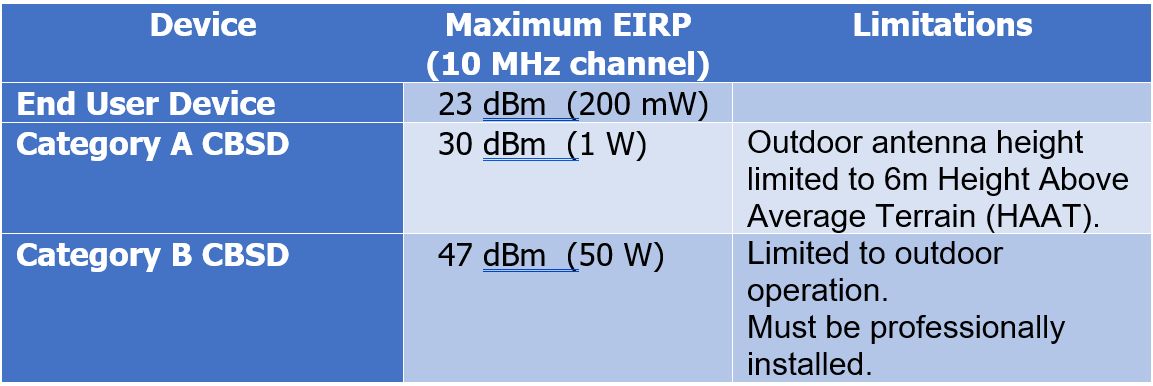
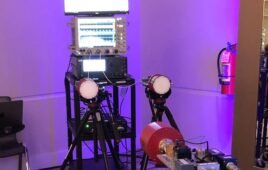


Thanks for your article on CBRS. I am with WInnforum, the SDO.